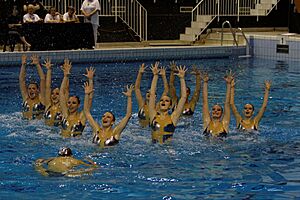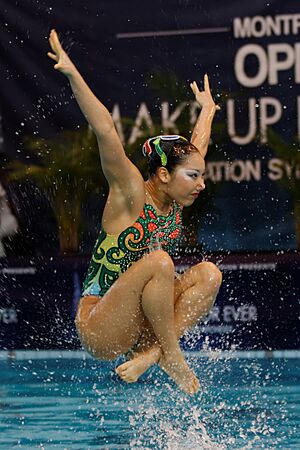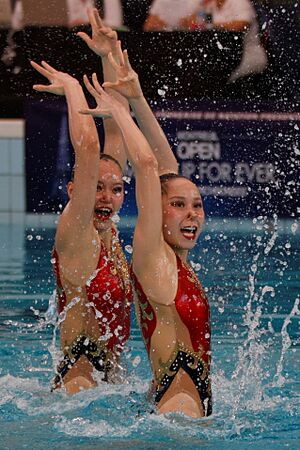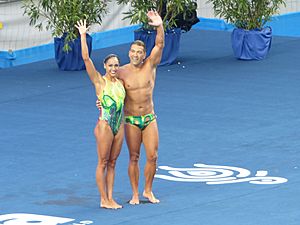Synchronized swimming facts for kids

The Czech synchronized swimming team performing a routine in 2013.
|
|
| Highest governing body | World Aquatics (formerly known as FINA) |
|---|---|
| Characteristics | |
| Contact | No |
| Type |
|
| Venue | Swimming pool |
| Presence | |
| Olympic | Yes |
Synchronized swimming, also called artistic swimming, is a sport where swimmers perform a planned routine in the water. They move together with music. This sport is managed by World Aquatics around the world.
It has mostly been a sport for women. However, in 2015, a new competition for mixed duets (one male and one female swimmer) was added. Starting in 2024, men can also join the team event at the Summer Olympics. Synchronized swimming has been an Olympic sport since 1984.
Contents
Basic skills
To be good at synchronized swimming, you need to learn some special moves. These help swimmers stay above water and perform amazing tricks.
Sculls
Sculls are hand movements that help swimmers move through the water or stay in one place. They are very important. One common scull is the support scull. It helps swimmers hold their bodies upside down in the water.
To do a support scull, you hold your upper arms close to your body. Your forearms are bent at a right angle, with your hands facing the bottom of the pool. You then move your forearms back and forth. This creates pressure against your hands, allowing you to keep your legs out of the water while upside down.
Eggbeater
The "eggbeater kick" is another key skill. It is a way of treading water that helps swimmers stay steady and high above the water. This kick leaves their hands free to make arm movements. Swimmers can often get up to their collarbone level using this kick.
The eggbeater kick is used in parts of a routine where swimmers are upright. Sometimes, swimmers do a "body boost." This uses a strong eggbeater kick to push them vertically out of the water. A body boost can lift a swimmer out of the water up to their hip level!
Lifts and highlights
Lifts and highlights are exciting parts of a routine. This is when some team members push another teammate high out of the water. These moves are common in routines for older and more skilled swimmers.
There are many types of lifts. They can include partner lifts or other creative moves. These are meant to really impress the judges and the audience.
Parts of a lift
Every lift has three main parts:
- The Flyer: This is usually the smallest swimmer on the team. Flyers need to be quick and flexible. It helps if they have a background in gymnastics, especially if they jump off the lift.
- The Base: This swimmer is usually of average size. They need very strong legs and a strong core. They must also be able to hold a squat position underwater.
- The Pushers: These team members provide the power. They help the base stand up quickly and the flyer gain height out of the water. Sometimes, there is no base, and the pushers lift the flyer directly.
Common types of lifts
- The platform lift is one of the oldest types. The base lies flat on their back underwater. The flyer squats on the base's body and stands up when the lift reaches the surface. Other teammates use the eggbeater kick to support the platform and the flyer.
- The stack lift is the most common type. The base squats a few feet underwater. The pushers hold the base's feet or legs. The flyer then squats on the base's shoulders. As the lift rises, everyone extends their arms and legs to get the most height. Swimmers often spin while going up or down in a stack lift.
- A toss or throw is set up like a stack lift. But when the lift reaches its highest point, the flyer jumps off the base's shoulders. They usually do an acrobatic move or hold a special position in the air. This is a very hard lift and only for experienced swimmers.
- A basket or bunken toss is a newer type of highlight. Two pushers interlock their hands to create a small platform. The flyer stands on their hands. The base is upside down, standing on the underside of the pushers' hands. Other swimmers help lift the pushers' waists and keep the base vertical. These lifts are often used by national teams to get the flyer very high out of the water.
Positions
There are many different body positions in synchronized swimming. Swimmers combine these to create endless routines. Here are a few basic and common ones:
- Back Layout: The swimmer floats straight and stiff on their back, sculling under their hips.
- Back Tuck Somersault: Start on your back. Bring your legs to your chest and spin backward in a full circle. Then straighten your legs to finish in a back layout.
- Ballet Leg: From a back layout, one leg is held straight up, pointing to the sky. The other leg stays flat on the water.
- Bent Knee (or Heron): While standing straight up in the water, one leg stays vertical. The other leg bends so its toe touches the knee of the vertical leg.
- Crane (or Fishtail): While standing straight up in the water, one leg stays vertical. The other leg drops flat on the surface, making an "L" shape.
- Double Ballet Leg: Like the ballet leg, but both legs are held straight up, pointing to the sky.
- Flamingo: Similar to ballet leg, but the bottom leg is pulled into the chest. The shin of this leg touches the knee of the vertical leg, staying flat on the water.
- Front Layout: Like a back layout, but the swimmer is on their stomach, sculling by their chest. They do not breathe in this position.
- Front Walkover: Start on your stomach. Scull down into a pike position (body bent at the hips). Lift one leg straight up. Lower that leg into a split position. Lift the other leg straight up. Lower that leg and scull over your head to finish on your back.
- Knight: The swimmer arches their back on the surface. Their legs are flat on the water, and their head is directly above their hips. One leg is lifted straight up.
- Side Fishtail: One leg stays vertical. The other leg extends out to the side, flat on the water, making a "Y" shape.
- Split Position: While standing straight up in the water, one leg is stretched forward along the surface. The other leg is stretched back along the surface, like an upside-down split.
- Tower: Start on your stomach. Scull down into a pike position. Lift one leg straight up. Lift the other leg straight up and then go down into the water.
- Tub: Both legs are pulled up to the chest. The shins and tops of the feet are dry and flat on the water's surface.
- Vertical: The swimmer holds their body completely straight, upside down, and perpendicular to the water. Usually, both legs are entirely out of the water.
Routine
Routines are made up of leg movements (called "figures"), arm sections, and highlights. Swimmers must move in sync with each other and with the music. During a routine, swimmers can never touch the bottom of the pool. They use sculling with their arms and the eggbeater kick to stay afloat.
After the performance, judges score the swimmers. They look at how well the moves are done (execution), how artistic the routine is (artistic impression), and how hard the routine is (difficulty). Doing the skills well, making cool patterns, and staying perfectly in sync are all important for a high score.
Technical vs. free routines
In some competitions, swimmers do a "technical" routine. This routine has specific moves that must be done in a certain order. The technical routine replaces an older "figure" event.
Swimmers also perform a longer "free" routine. This routine has no set rules. It's a chance for swimmers to be creative and show off their unique choreography.
Length of routines
The type of routine and competition level decide how long routines are. Routines usually last two to four minutes. Solo routines are the shortest. Routines get longer as more swimmers are added, like duets, teams, or combo routines. The age and skill level of the swimmers also affect the required routine length.
Scoring
Free routines used to be scored out of 100 points. Points were given for execution, artistic impression, and difficulty. In 2021, the scoring system changed. Now, difficulty and execution are worth more than artistic impression. This means free routines no longer have an upper limit on scores. Technical routines also get points for how well they do specific technical moves.
In group routines, a team usually has 8 swimmers for big events. If a swimmer touches the bottom of the pool, they get a penalty. If they push off the bottom, they can be disqualified (removed from the competition).
Preparation
When swimmers practice and compete, they wear a rubber noseclip. This stops water from going into their nose when they are underwater. Some swimmers also wear earplugs.
For competitions, hair is put into a bun. Special flavorless gelatin (like Knox) is used to keep the hair perfectly in place. A pretty headpiece is then pinned or sewn to the bun. Swimmers wear custom swimsuits. These suits are often decorated with bright fabric and sequins to match the music. The costume and music are not judged, but they make the routine look even better.
Swimmers also wear makeup. However, rules now say that makeup should look more natural. No "theatrical" makeup is allowed. It should just give a natural, healthy glow.
Underwater speakers help swimmers hear the music. This helps them stay in sync with each other. Coaches also use underwater speakers to talk to swimmers during practice. Swimmers wear goggles during practice, but they are not allowed in competitions unless a swimmer has a medical reason.
Competitions
Figures
A competition often starts with swimmers doing "figures." These are individual movements and positions done without music. All swimmers must wear a standard black swimsuit, a white swim cap, goggles, and a noseclip. Judges score each swimmer from 1 to 10. If a swimmer does not do the correct figure, they might get a zero. Figures are usually only done by swimmers under 15 or 16 years old.
United States
In the United States, swimmers are grouped by age. There are groups like 12 and under, 13–15, and older. Younger swimmers can also be grouped by skill level: Novice, Intermediate, and Age Group. Swimmers compete in events like solo, duet, combo (10 swimmers), and team (8 swimmers). For younger age groups, figure scores are added to routine scores to find the final winners. For older groups, technical and free routine scores are combined.
Canada
In Canada, synchronized swimming also has age groups like 10 & under, 12 & under, and 13–15 for provincial levels. There are also national stream levels for more advanced swimmers, including 13–15, Juniors (16–18), and Seniors (18+). There are also "recreational" levels called "stars." The Canadian University Synchronized Swimming League (CUASL) lets university students keep swimming. It also has a "Novice" group for those new to the sport.
Men's and mixed competition
Some competitions around the world now allow men to compete. In 2015, World Aquatics (FINA) added a new mixed duet competition at the World Aquatics Championships.
In the late 1800s, synchronized swimming was actually only for men. But in the 1900s, it became a women's sport, and men were often not allowed. In the U.S., men could compete with women until 1941. After that, men and women had to compete separately, which led to fewer male swimmers.
In 1978, the U.S. changed its rules to let men compete with women again. Rules in other countries were different. In the UK, men could not compete until 2014. In France, Benoît Beaufils competed in national events in the 1990s. American Bill May was a top male swimmer in the late 1990s and early 2000s. He won medals in international events. However, men were still not allowed in the biggest competitions, like the World Championships and the Olympics.
When the mixed duet event was added in 2015, Bill May and Benoît Beaufils came out of retirement to compete. They competed against younger swimmers like Aleksandr Maltsev from Russia and Giorgio Minisini from Italy. Pairs from ten countries competed in these first mixed events.
In 2022, FINA allowed men to compete as soloists in some events. The International Olympic Committee also allowed up to two men per team of eight in the mixed gender team event at the 2024 Olympic Games. Men's solo events are planned to start at the senior World Championships level in 2023.
|
See also
 In Spanish: Natación sincronizada para niños
In Spanish: Natación sincronizada para niños
- NHK Twinscam
- Swimming (sport)
- Water aerobics
- Water polo
- Composite stroke
- List of synchronised swimmers




